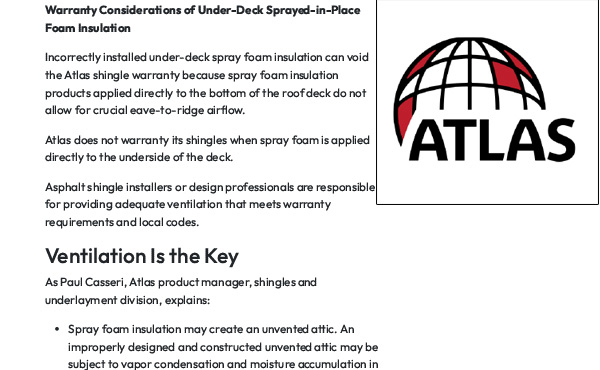Insulation Baffles and Spray Foam Insulation

Insulation baffles
help maintain an air gap between the insulation and the roof deck; they also help direct air movement and prevent wind from blowing the insulation out of place.
If the attic space is going to be conditioned, either for living or mechanical purposes, or if a home design calls for a vaulted ceiling, provision R806.3 in the International Residential Code calls for the roof deck above the space to be vented continuously from the eave to the ridge. This is easy to accomplish in simply constructed roofs and difficult, if not impossible, to accomplish in roofs that have hips, valleys, dormers, or skylights that interrupt the rafter bays.
“The success … hinges on the ceiling of the top level of the house being absolutely airtight before any insulation is installed.”

Spray foam insulation
is a great product for maintaining a consistant temperature within a structure. Insulation baffles compliment spray foam by providing seamless airflow under the roof deck keeping the airflow from eave to ridge. Baffles should be used prior to an installation of spray foam to maintain the shingle warranty and most importantly to prevent any moisture build up from under the roof deck that could cause mold or rot.
The Need for Ventilation as Described in ICC Building Codes
In the 2024 ICC Building Codes (IBC), attic ventilation is addressed as, “An airspace of not less than 1 inch (25 mm) shall be provided between the insulation and the roof sheathing.” SmartBaffles exceed that requirement by providing 2 inches of airspace insuring a clear and up to code airflow.
SmartBaffles for use with all insulation types
SmartBaffle is available in 16” and 24” On Center rafter.These stock sizes will fit snuggly in common 14.5″ and 22.5″ rafter bays. These insulation baffles are strong, durable, easy to work with and can be used in new construction or retrofit during renovations.
Are You Risking Your Shingle Warranty?
Before you contract to have spray foam insulation installed in an attic space you may want to install SmartBaffles prior spray foam to ensure the shingle warranty is not going to be impacted. Most manufacturers will require ventilation that would meet or exceed building codes.
From Owens Corning Technical Bulletin (TB-10023711):
“Ventilation systems should provide balanced intake and exhaust with adequate net free vent area (NFVA) that meets or exceeds code requirements. Not venting attics may introduce moisture related problems in the attic, and moisture management issues can lead to mold and damage to the internal structure of a home. Further, installing a spray foam system can make it more difficult to detect roof leaks.”
From GAF Technical Advisory Bulletin (TAB-R-135):
Will Sprayed-In-Place Foam Insulation Void My Warranty?
No, the GAF Shingle Limited Warranty against manufacturing defects will remain in effect.
However, any damage to the shingles attributable to using sprayed-in-place insulation
directly applied to the roof deck or lack of ventilation is excluded from GAF’s responsibility
under the terms of our Limited Warranty.
From Atlas Roofing (atlasroofing.com)
Correct Installation of Spray Foam to Maintain the Warranty
Atlas Roofing does approve and warranty the use of Atlas shingles with spray foam in certain situations:
The system must maintain a free flow of air on the underside of the roof deck from soffit to ridge.
Baffles should be installed between the rafters before spray foam insulation.
Fine Hombuilding: Joseph Lstiburek
From: A Crash Course in Roof Venting
So much information has been devoted to the subject of roof venting that it’s easy to become confused and to lose focus. So I’ll start by saying something that might sound controversial, but really isn’t: A vented attic, where insulation is placed on an air-sealed attic floor, is one of the most underappreciated building assemblies that we have in the history of building science. It’s hard to screw up this approach. A vented attic works in hot climates, mixed climates, and cold climates. It works in the Arctic and in the Amazon. It works absolutely everywhere—when executed properly. – Full article





